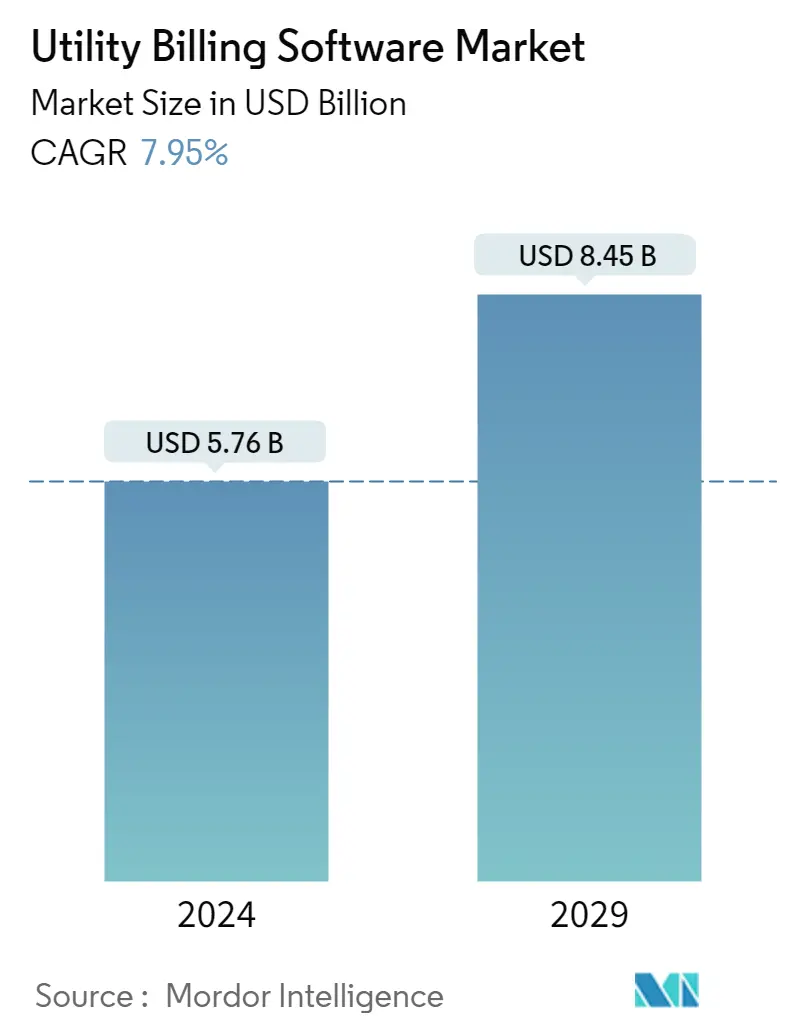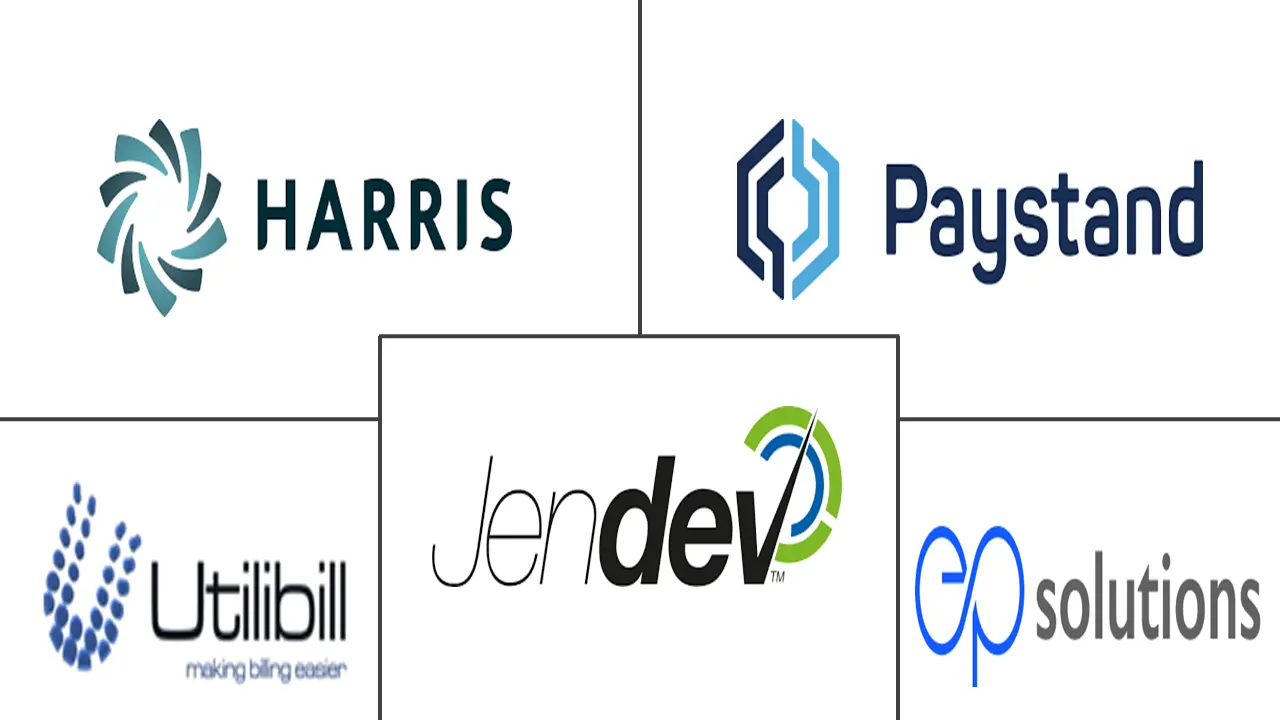Market Size of Utility Billing Software Industry

| Study Period | 2019 - 2029 |
| Market Size (2024) | USD 5.76 Billion |
| Market Size (2029) | USD 8.45 Billion |
| CAGR (2024 - 2029) | 7.95 % |
| Fastest Growing Market | Asia Pacific |
| Largest Market | North America |
Major Players
*Disclaimer: Major Players sorted in no particular order |
Utility Billing Software Market Analysis
The Utility Billing Software Market size is estimated at USD 5.76 billion in 2024, and is expected to reach USD 8.45 billion by 2029, growing at a CAGR of 7.95% during the forecast period (2024-2029).
Utility billing software assists in managing utility operations, customer data, and billing duties for water, sewer, gas, electric, waste management, and sub-metering firms. Utility Billing Systems are used by businesses to streamline customer administration and billing procedures while integrating service orders, meter maintenance history, and scheduling to increase productivity and profitability.
- To match the changing dynamics of the utility business, legacy billing systems have undergone significant changes, such as the incorporation of cloud computing and Internet of Things (IoT) technologies. This has contributed to the market's expansion.
- Additionally, digitalization covers the conveyance of information and the information itself. Energy firms are concentrating on sustainable and paperless solutions for an effective working environment even though the legacy billing system has been improving over time, and there are no strict limitations on carbon emissions. This change has also prompted businesses to install better IT infrastructure.
- One of the key drivers propelling the worldwide utility billing software industry is the continuous upgrading of legacy billing systems. The electrical power supply industry's increasing adoption of smart grid technology, such as smart meters, has raised complexity in the utilities' billing and collection infrastructure.
- The utility industry is finding it more challenging to satisfy its clients due to the fast-changing industrial environment, the existence of technologically advanced consumers, and the convergence of digital devices and technology coupled with traditional business processes. Keeping customers happy has become difficult in today's fiercely competitive marketplaces, primarily service-based industries that rely on customer satisfaction.
- The impact of COVID-19 has been felt across different end-user industries. For instance, as the coronavirus spread, access to water emerged as a critical tool, allowing people to clean surfaces and wash their hands regularly. To ensure this, some governments ordered utilities to provide it for free or at discounted rates, but those utilities are now struggling.
Utility Billing Software Industry Segmentation
Utility billing software provides an effective billing solution to help municipalities and officials manage their daily operations. This software offers effective billing, and the collection system forms the core of successful utility businesses. Utility bills usually refer to water, electricity, and gas bills. It can also include accounts for essential services like sewer services, such as those provided by the council.
The Utility Billing Software Market is segmented by Deployment Mode (Cloud-based, On-premises), End-user Industry (Water, Oil & Gas, Power Distribution, Telecommunication), and Geography (North America (United States, Canada), Europe (Germany, UK, France, and Rest of Europe), Asia Pacific (India, China, Japan, and Rest of Asia-Pacific), and Rest of the World).
The market sizes and forecasts are provided in terms of value (USD million) for all the above segments.
| By Deployment Mode | |
| Cloud-based | |
| On-premise |
| By End-user Industry | |
| Water | |
| Oil & Gas | |
| Power Distribution | |
| Telecommunication | |
| Other End-user Industries |
| By Geography | ||||||
| ||||||
| ||||||
| ||||||
| Rest of the World |
Utility Billing Software Market Size Summary
The Utility Billing Software Market is poised for significant growth, driven by the need for modernized billing systems that can handle the complexities of today's utility operations. These software solutions are essential for managing customer data and billing processes across various sectors, including water, gas, electricity, and waste management. The integration of cloud computing and IoT technologies has transformed legacy systems, making them more efficient and capable of supporting sustainable, paperless operations. This evolution is crucial as utility companies strive to enhance customer satisfaction in a competitive landscape where digitalization and smart technologies are becoming the norm. The market's expansion is further supported by the increasing adoption of smart grid technologies, which necessitate more sophisticated billing and collection infrastructures.
North America is expected to dominate the market due to its advanced utility infrastructure and the availability of funding for operational improvements. The United States, in particular, benefits from early adoption of innovative technologies like Blockchain and IoT, which are driving market growth. The digital transformation in the energy sector is enabling companies to leverage data analytics for better decision-making and improved customer experiences. The shift towards cloud-based IT operations is also providing utilities with opportunities to optimize costs and enhance resilience. The market is characterized by a diverse range of suppliers and is witnessing mergers and acquisitions, alongside technological advancements that are expected to propel global growth.
Utility Billing Software Market Size - Table of Contents
-
1. MARKET INSIGHTS
-
1.1 Market Overview
-
1.2 Industry Attractiveness - Porter's Five Force Analysis
-
1.2.1 Bargaining Power of Suppliers
-
1.2.2 Bargaining Power of Buyers
-
1.2.3 Threat of New Entrants
-
1.2.4 Intensity of Competitive Rivalry
-
1.2.5 Threat of Substitutes
-
-
1.3 Assessment of Impact of Covid-19 on the Market
-
-
2. MARKET SEGMENTATION
-
2.1 By Deployment Mode
-
2.1.1 Cloud-based
-
2.1.2 On-premise
-
-
2.2 By End-user Industry
-
2.2.1 Water
-
2.2.2 Oil & Gas
-
2.2.3 Power Distribution
-
2.2.4 Telecommunication
-
2.2.5 Other End-user Industries
-
-
2.3 By Geography
-
2.3.1 North America
-
2.3.1.1 United States
-
2.3.1.2 Canada
-
-
2.3.2 Europe
-
2.3.2.1 Germany
-
2.3.2.2 United Kingdom
-
2.3.2.3 France
-
2.3.2.4 Rest of Europe
-
-
2.3.3 Asia Pacific
-
2.3.3.1 China
-
2.3.3.2 Japan
-
2.3.3.3 India
-
2.3.3.4 Rest of Asia Pacific
-
-
2.3.4 Rest of the World
-
-
Utility Billing Software Market Size FAQs
How big is the Utility Billing Software Market?
The Utility Billing Software Market size is expected to reach USD 5.76 billion in 2024 and grow at a CAGR of 7.95% to reach USD 8.45 billion by 2029.
What is the current Utility Billing Software Market size?
In 2024, the Utility Billing Software Market size is expected to reach USD 5.76 billion.

